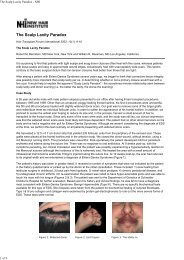The Patient's Guide to Hair Restoration - New Hair Institute
The Patient's Guide to Hair Restoration - New Hair Institute
The Patient's Guide to Hair Restoration - New Hair Institute
You also want an ePaper? Increase the reach of your titles
YUMPU automatically turns print PDFs into web optimized ePapers that Google loves.
attention <strong>to</strong> measuring hair density, and even less commonly record it in the<br />
patient’s file. ine <strong>Hair</strong> Caliber<br />
Although not affected by the transplant, hair shaft diameter is an extremely<br />
important contribu<strong>to</strong>r <strong>to</strong> hair volume and thus the available hair supply. <strong>Hair</strong> shaft<br />
diameter is mentioned less often than the actual number of hairs because it is<br />
more difficult <strong>to</strong> measure, but its importance <strong>to</strong> both the virgin transplant and <strong>to</strong> a<br />
repair cannot be overemphasized. Variations in hair shaft diameter have an<br />
approximately 2.7 times greater impact on the appearance of fullness than the<br />
absolute number of hairs.<br />
<strong>The</strong> importance of this in a repair is that, for a given degree of plugginess,<br />
fine hair will provide less camouflage than coarser hair. Fine hair, therefore,<br />
must be transplanted in greater numbers, or in multiple sessions, <strong>to</strong> achieve the<br />
same results. When this quantity of hair is not available, compromises must be<br />
made in the repair. This important issue should be discussed with patients who<br />
have fine hair prior <strong>to</strong> the repair, so that priorities can be established in advance.<br />
Poor Scalp Mobility<br />
Donor density and hair shaft diameter are not the only fac<strong>to</strong>rs affecting the<br />
available donor supply. In order for an adequate amount of hair <strong>to</strong> be harvested,<br />
there needs <strong>to</strong> be sufficient scalp laxity (looseness) <strong>to</strong> close the wound after the<br />
donor strip is removed. Especially when there is low donor density, having<br />
adequate laxity is especially important because a widened scar may be visible<br />
through the thin hair.<br />
<strong>The</strong> location of the donor incision greatly affects scalp mobility. <strong>The</strong> ideal<br />
position for the donor incision is in the mid-portion of the permanent zone. <strong>The</strong><br />
muscles of the neck insert in<strong>to</strong> the deeper tissues of the scalp just below that<br />
area. <strong>The</strong> problem is that an incision placed below this area will be affected by<br />
the muscle movement directly beneath it. A stretched scar in this location is<br />
extremely difficult <strong>to</strong> repair since re-excision, even with undermining and layered<br />
closure, will tend <strong>to</strong> heal with an even wider scar.<br />
<strong>The</strong> main risk of placing the scars <strong>to</strong>o high is the lack of permanence of<br />
the transplanted hair (it may be subject <strong>to</strong> androgenetic alopecia), and future<br />
visibility of the scar if the donor fringe were <strong>to</strong> narrow further.<br />
Scarring<br />
Scarring in the donor area limits the amount of hair accessible <strong>to</strong> the<br />
surgeon for a number of reasons. <strong>The</strong> most obvious reason is that a larger<br />
donor strip must be removed <strong>to</strong> harvest the same amount of hair. <strong>The</strong> second,<br />
mentioned above, is that scarring decreases scalp laxity by destroying elastic<br />
tissue and often destroying the subcutaneous layer causing the scalp skin <strong>to</strong> be<br />
bound down <strong>to</strong> the deeper tissues. <strong>The</strong> third is that scars themselves present<br />
cosmetic problems when visible, so more donor hair must be left <strong>to</strong> cover a<br />
scarred area than <strong>to</strong> cover normal scalp.<br />
<strong>The</strong> presence of open donor scars, made by the old punch technique may<br />
give a false sense of security. Because an excision with a primary closure was<br />
not performed, the patient’s donor laxity has not been compromised. This<br />
thinking may lure the unwary surgeon in<strong>to</strong> harvesting a donor strip that is <strong>to</strong>o<br />
wide. When the surgeon attempts <strong>to</strong> close the donor wound, the tight closure



